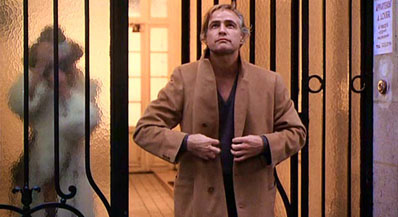The Insert Shot: Last Tango in Paris
Why Bertolucci's Masterpiece Needs and Earns Every Dirty, Filthy Moment
By Tom Houseman
March 8, 2012
Some people make the argument that it is not necessary to show sex scenes in films. Their point is that the sex itself does not develop the characters, further the plot, or move the conflict in any significant way. Rather, it is the scenes that take place around the sex that are relevant, and by showing the act itself you are merely distracting from the plot and conflict with needless eroticism and titillation. Take the film Closer, for example, which is all about the sexual exploits of two couples who break up and get back together over a series of years. While the characters constantly talk about sex, and sex plays an important role in their relationships and affairs, we never see anyone do anything more than kiss. The point being made by Patrick Marber (who wrote both the play and the screenplay) is that the act of sex does not matter as much as the ramifications of the act, the way it is talked about and what the characters take away from it.
But this is a fairly limiting perspective, and while Closer is a very effective film, it is possible to make a film about sexual exploits that is as effective, and perhaps more effective, by showing the characters having sex with each other. It is possible that Bernardo Bertolucci's intention was not to create a film about the way we have sex and what it says about us as people, how we interact with lovers and cope with grief. It is possible that he just wanted to tell a story about a young woman coming of age and a middle aged man attempting to restart his life. But by showing the graphic and sometimes disturbing sex that these two characters have, Bertolucci gave us far more insight into these characters than would be possible just by seeing them talk to each other, regardless of the topic. Showing the way that Paul and Jeanne have sex helps us understand their inner conflict and how they are using each other, and attempting to control each other, as a way of dealing with their personal issues.
Last Tango in Paris follows two characters who begin a sexual affair that becomes abusive. Paul is in his mid-40s and dealing with the suicide of his wife, for whom he moved to France five years before. He was aware of her multiple sexual affairs, but did not have any of his own. He meets Jeanne, who is 20 and in a relationship with a young filmmaker, in one of the rooms of the hotel that he and his wife ran with his wife's mother. Paul is attempting to retake control of his life. His wife's infidelity and suicide, as well as the fact that he is on the wrong side of middle age, have him questioning his masculinity and his sense of power. He is desperate for affirmation, for a situation in which he has total control. Jeanne presents him with such a situation. She is young, naïve, and at a very different crossroad in her life. She is looking to forge her own identity, to prove to herself and the world that she is a woman, not a girl.
Their first meeting reveals their attempts to redefine themselves and establishes the power dynamic in their relationship, mainly through their sexual interactions. Jeanne is looking at a room in Paul's hotel, and finds that he is already there. They both immediately size each other up, speaking cautiously and watching each other move around the room warily. Jeanne thinks that Paul is also interested in renting the room: “So you're going to take it,” she assesses. “You decided.” Jeanne sees Paul as a powerful man who takes what he wants, and Paul recognizes that.
Continued:
1
2
3




